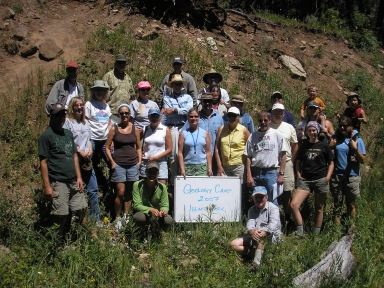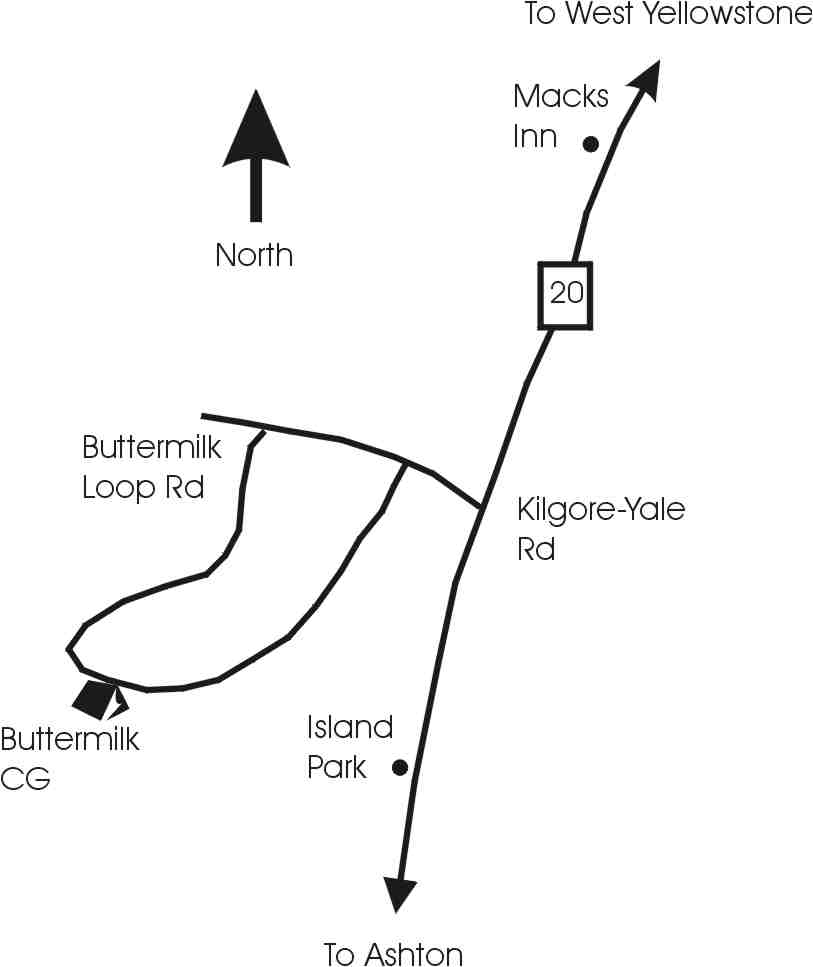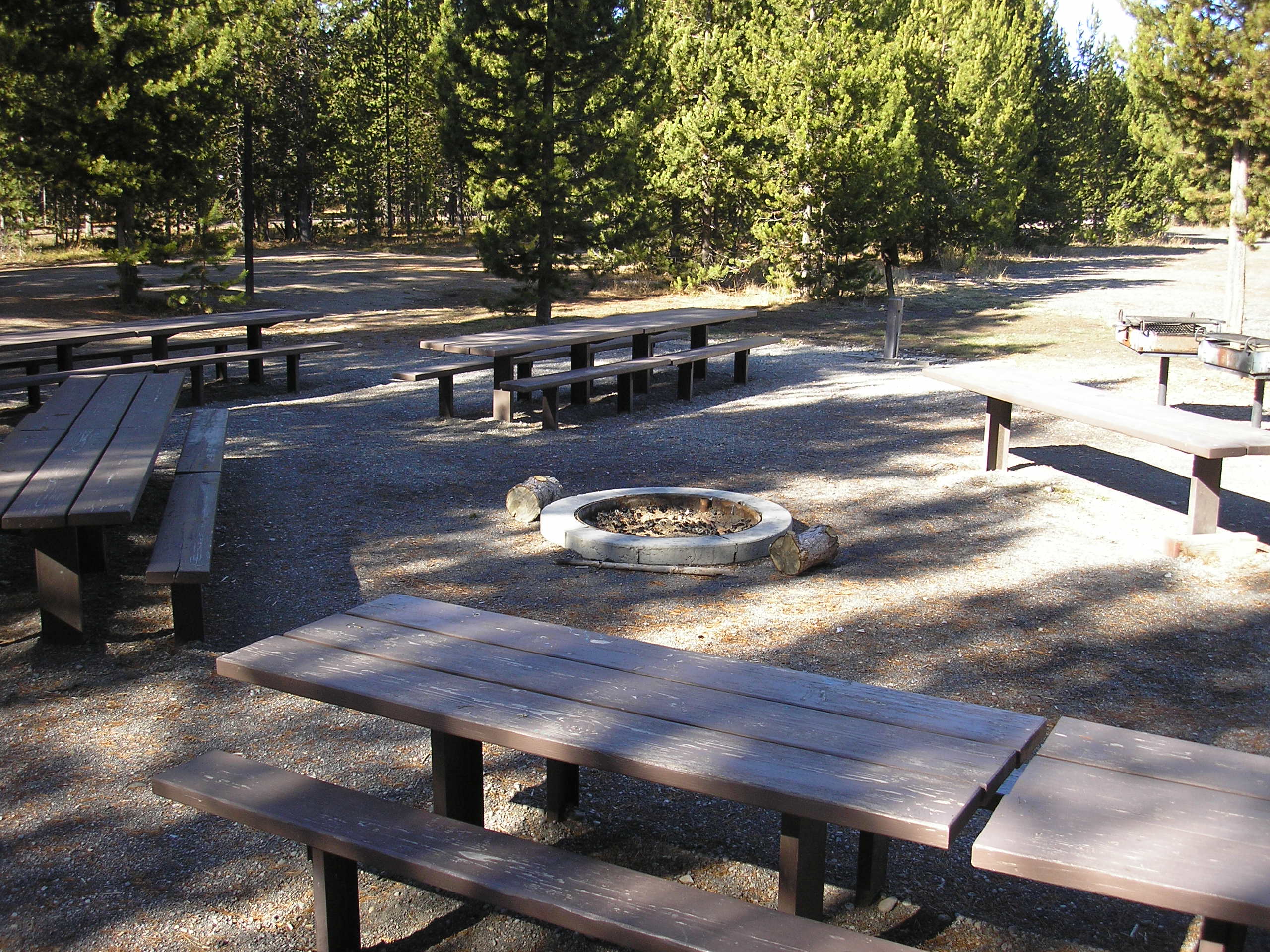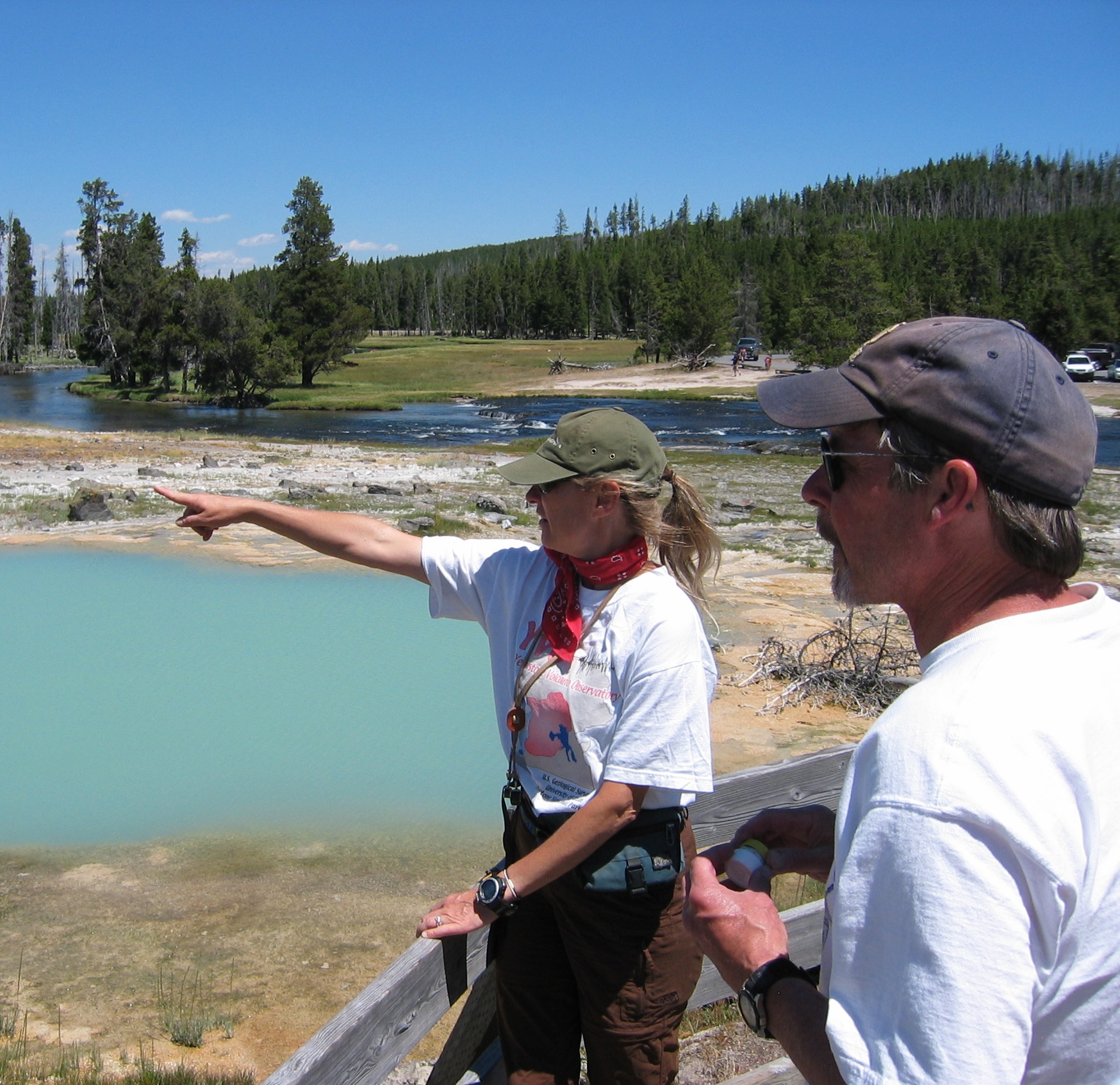2007 Idaho Earth Science Educator Field
Workshop
Island Park, Idaho
July 8-13, 2007

2007 Workshop Participants at 1959 Hebgen Lake Earthquake Fault
Scarp (IGS photo)
Introduction
Welcome
to
the Idaho Geological Survey's Summer
Field
Workshop for Idaho
Earth Science Educators. Each summer in July, the IGS takes earth
science
teachers out of their classrooms and back to the field for an exciting
week of
field trips and projects organized around the topic of natural hazards.
This
website documents the 2007 workshop.
Are
you interested in attending the
IGS summer field workshop? For more information, click on one of these
links or contact Bill Phillips.
- 2008 Workshop, Ponderosa State
Park, McCall, Idaho (coming soon)
For More Information Contact:
Bill Phillips
Idaho Geological Survey
PO Box 443014
University of Idaho
Moscow, ID 83844-3014
telephone: (208)885-8928
email: Phillips
Email Address
Acknowledgments:
This workshop
is funded by the Idaho Bureau of Homeland Security, FEMA, and the Idaho
Geological Survey. Additional support
is provided by the Idaho Mining Association and the National Energy
Foundation. We thank the Idaho Earth Science Teachers Association for
their help advertising the workshop. Special thanks to Cheryl
Jaworowski and Hank Heasler (Yellowstone National Park), and Dean
Garwood (IGS). Finally, muchas gracias to the teachers for their
enthusiasm and help with the daily logistics of the workshop.
Island Park Area
The 2007 workshop
was held at the Buttermilk
Campground Group Site
in Island Park,
about 54 miles north of Idaho
Falls.
Island Park
lies in the Henrys Fork Caldera adjacent to Yellowstone National
Park.
The area contains an outstanding assortment of ancient and modern
geological
features including fault scarps, lava flows, pumice, obsidian, hot springs,
and glacial moraines.

Location map of the 2007 Field Workshop
L: Snotel Mountain near Island Park ; C:
Earthquake Lake, created by 1959 Hebgen Lake Earthquake; R: Hebgen Lake
from
Horse Butte (photos Bill Phillips, IGS)
Workshop Activities
As
in other years, the workshop focus was on natural
hazards. This year, we examined the amazing Island Park
area. With so much to see, participants were kept busy from 8 am to 5
pm plus
activities such as movies or lectures on most evenings. Here is a brief
summary of what we did during the week. For a more detailed schedule,
download the Workshop Pamplet.
This also contains
many maps, location of field stops, and staff biographies.
.
Sunday, July 8: Workshop
participants arrived during the afternoon to register and set up camp
on
the shores of Island Park Reservoir. Dinner was
an
icebreaker barbecue sponsored by IESTA, the National
Energy Foundation, and the Idaho Mining Association. Special thanks to
Jim Wilcox for his help making the barbecue happen in a sudden rain
storm. After dinner, the workshop began with a Survey of Geologic Hazard Teaching
Practices by Idaho Teachers (multi-year study conducted by Bill
Phillips). Then,
Hank Heasler
(Yellowstone National Park) presented a in-depth lecture on the
geologic setting and natural hazards of the Greater Yellowstone
area. Many of us were amazed to learn that not only does Yellowstone
have earthquakes, lava flows, ash flow tuffs, hydrothermal explosions,
and those famous geysers, but also dangerous concentrations of CO2 that
may have killed a herd of bison. Hank's lecture did an excellent job
of setting the stage for the next
several days of field trips.
2007 Results of Geologic
Hazard Teaching Practices by Idaho Teachers (pdf download)

Buttermilk Campground Group Site (photo Bill Phillips,
IGS)
Monday, July 9: Cheryl Jaworowski (Yellowstone National Park) guided the group to Old Faithful
and Upper Geyser Basin areas of Yellowstone National Park. We witnessed
an eruption
of Old Faithful, walk around geyers and hot pools, got a close up view
of a rhyolite lava flow, and begin to appreciate the complexity
and power of this fascinating area. July is a prime time to visit
Yellowstone and we were literally surrounded by hundreds of fellow
park
visitors. The risk posed each day
during the summer by natural hazards to these
thousands
of tourists was made clear, particularly when Cheryl showed us a
recent
hydrothermal steam explosion crater and its debris. A favorite for many
of us was Cheryl's demonstration of constructing a time line of
geological
events using rope and labels. This is a great way to introduce the
concepts of geologic time to students. We all benefited tremendously
from Cheryl's enthusiasm and knowledge on this trip and during the
remainder of the workshop. Thanks,
Cheryl!
To top off a long day, a group of die-hard participants
viewed the movie "Supervolcano" in the
campground. This is a good resource for educators,
particularly when the audience is not so sleepy!
L: Old Faithful erupts (at last); C:
Cheryl
points out hydrothermal explosion debris to Randy; R: Site of
hydrothermal explosion (photos Bill
Phillips and Jim Cash, IGS)
Tuesday, July 10: We
rise again early for another full day of field trips, this time led by Bill Phillips
and Roy
Breckenridge (IGS). Today's focus is on the 1959 Hebgen Lake
earthquake. With a magnitude of 7.3,
this earthquake was the most powerful recorded in the Rocky
Mountains. We began with a short exercise mapping stream terraces on
air photos
on the Madison
River at Missouri Flats. This area has a great view of Holocene fault
scarps at the base of the Madison Range and the stream terraces have
been deformed by
Quaternary tectonism. Next we visited Earthquake Lake where an
enormous earthquake-induced landslide dammed the Madison River, killing
23
people. We viewed the National Forest Service video on the 1959
earthquake. The video is quite good, particularly in terms of
documenting the cost to
human life and property. While at the landslide overlook, we practiced
collecting mineral sets for teaching. At the next stop, we took a group
photo at
the scarp of the 1959 earthquake, and discussed radiometric dating and
fault hazard analysis. Then, we moved on to Hebgen Lake Dam and nearby
damaged road and
building sites. These stops demonstrated how vulnerable dams
and reservoirs can be to severe earthquakes. The touring of earthquake
damaged facilities
is a great idea for hazard educators. We ended up the day on top of
Horse Butte where we discussed the Bull Lake glaciation of the
area. After
dinner, we gathered for Judy Walling's (Meridian
School District) presentation of the Out
of the Rock workshop. This
workshop focuses on
instructional methods for introducing earth materials and natural
resource concepts to students. It is particularly strong on
mineral ID kits.
L: Participants viewing 1959 Hebgen Lake Earthquake Landslide
Site; C: Fred, Jacque, and Judy mapping stream terraces at
Missouri Flats; R: Missouri Flats with Holocene fault scarps on Madison
Range (photos Bill Phillips and Roy
Breckenridge, IGS)
Wednesday,
July 11: After two long
days of field trips, we were ready for a bit of a change. Dave Jackson
(Idaho Bureau of Homeland Security) presented an entertaining and
informative
mini-workshop on Natural Hazard Mitigation. Refreshed and still
chuckling, we
climbed aboard the vans for one more afternoon of field trips. This
time, Bill
Phillips led a tour of the Henrys Fork Caldera. This
feature, often improperly called the Island Park Caldera,displays
volcanic features and landforms particularly well. We started at Big
Springs (huge springs
discharging from the base of a Yellowstone Plateau rhyolite flow), then
moved to the central floor of the caldera to discuss post-caldera
basalt flows and
rhyolite domes. A relatively unappreciated feature of the region is
the dissection of the caldera by streams, resulting in several
spectacular
waterfalls.At
Upper and Lower Mesa Falls, the processes of river incision and
knickpoint generation and migration were discussed. Then, after an
emergency ice cream break in Ashton, we
finished up the field trip with mineral collecting at an exposure of
the Mesa Falls Tuff. If all this were not enough, it was now party time
back at camp.
Dropping all pretension of scholarly activity, we enjoyed another
IESTA/NEF/IMA barbecue followed by the famous IESTA rock raffle.
Thanks to Jim Cash for his help with the Raffle, and
to Jena
Raino for
being such a great emcee. The Rock Raffle is the primary fund-raising
activity of IESTA. It is also run at the annual Idaho Science Teachers
Association meeting every fall.
L: Dave Jackson, hazard mitigation specialist
extrordinaire; C: Lucille (lower left) helps test pH at Big Springs; R:
Cathy
and Jim at the IESTA Rock Raffle (photos Bill Phillips, IGS)
Thursday, July 12: On
the last full
day of the workshop, it was time for participants to work on their
projects. To get them warmed up, Jim Cash (recently
retired from the Moscow School District) presented wisdom gleaned from
his many years of earth science teaching with a lecture on
"Incorporating geologic hazards in your teaching." Participants spent the remainder
of the day working on their projects.
Staff were available for technical help as well as transportation to
field sites. In the evening, participants gathered for the optional
IESTA Board Meeting. See the
IESTA website for more information about the activities of this
organization.
Friday, July 13: Participants
presented short teaching activities based on their workshop experiences, either in small teams of 2 or
3, or individually. These presentations are one of the
most important parts of the workshop. They give teachers a chance to
try out new ideas and gain feedback from their peers. Summaries of the
presentations are
archived below for download.
L: Jim Cash presents his lecture; C: Mike's
presentation was a real page-turner; R: Jean describes her time line
project for the Yellowstone Hot Spot track (Photos Bill Phillips and
Roy Breckenridge, IGS)
Workshop Pamplet (pdf
download)
2007 Participant Projects (pdf download)
2007
Workshop Evaluation (pdf download)
Overview of Jim Cash's Activities
(pdf download)
Borah Peak Activity
(pdf download)
Earthquake
Evacuation Lesson (pdf download)
Epicenter Activity
(pdf download)
Half-Life Activity
(pdf download)
Hebgen Lake
Earthquake (pdf download)
Risk Map Activity (pdf download)
Supervolcano Activity
(pdf download)
Types of Faults (pdf download)
More Workshop Photos
UL: Roy and Bill at Old Faithful; UC: Collecting Mesa Falls Tuff; UR:
Cheryl and George with glacial erratics at Horse Butte
LL: Cathy and Ted relax at the Rock Raffle: LC: Damaged road at Hebgen
Lake;
LR: Cathy and Kathleen in Yellowstone (IGS photos by Bill Phillips, Jim
Cash, and Roy Breckenridge)
2007 Workshop Staff
Bill Phillips, Workshop Organizer (IGS), Roy Breckenridge (IGS) ,
Jim Cash (Moscow School District, Retired)
Judy Walling (Meridian School District), Dave Jackson (Idaho Bureau of
Homeland Security)
2007 Guest Instructors
Cheryl Jaworowski (US National Park Service, Yellowstone National Park)
Hank Heasler (US National Park Service, Yellowstone National Park)
Further Educational Resources
Yellowstone Hot
Spot Information and Links
Yellowstone Volcano
Observatory (excellent source of information on Yellowstone
earthquakes and geology)
Yellowstone National Park (the
official US National Park Service website)
Snake
River Plain and Yellowstone Hot Spot (good introductory site by the
VolcanoWorld people)
Mantle Plumes
(complicated but fascinating website discussing the origin of mantle
plumes. Has a skeptical bias against conventional plume theory.
Technical and slightly wacky)
Is
Yellowstone Volcanism Caused by Deep-Seated Mantle Plume?(Technical
discussions and resources regarding mantle plumes and Yellowstone
features)
Real-Time
Earthquakes in the Yellowstone Area (check recent earthquake
activity near Yellowstone National Park)
Supervolcano
(Official BBC website for the movie thriller)
About
Summer Field Workshops for Idaho Earth Science Teachers
Offered
since 1986, the IGS summer field workshops are week-long sessions
designed to help
teachers develop lesson plans that increase awareness and understanding
of the
geology and natural hazards affecting Idaho.
The workshops also promote excellence in earth science education by
providing short
courses in geological concepts and methods, and by exposing educators
to new technologies
and theories. The workshops emphasize "learning through inquiry" in a
friendly, non-competitive, outdoor environment. They are open to all Idaho educators
regardless of prior training or experience in the earth sciences. Both
elementary and secondary teachers are welcome. Photos and other
information
about past workshops can be viewed at the IGS website (click here).
New!
Read FEMA Newsletter Article about the
Summer Teacher Workshops (click
here for pdf file)
Workshop Funding
Major
funding for the workshop is provided by the Idaho Bureau of Homeland
Security and the Idaho Geological Survey. Other co-sponsors are the
Idaho Association of Earth Science Teachers
(IESTA), the
Federal Emergency Management Agency,
the National
Energy Foundation and the Idaho Mining Association. For further
information about these agencies and organizations, see these links:
Idaho Geological Survey
Idaho Earth
Science Teachers Association
Idaho Bureau of Homeland Security
Federal Emergency Management Agency
National Energy Foundation
Idaho Mining Association
Workshop Fees
The
workshop is designed to be as inexpensive as possible for participants.
Costs are reduced by camping in public campsites. There is a $50
registration fee. Grants to the IGS cover camping fees,
course materials, and
transportation during the workshop. Participants are
responsible for
their own food
and transportation to/from the workshop.
Academic Credit
Participants
may optionally take
the
workshop for two academic credits through the University of Idaho.
Special fees for in-service Idaho teachers are available. Registration
for academic credit is conducted on-site at
the
first day of the workshop. Payment
is by cash or check only (credit cards are not accepted).
Workshop FAQ's
1. Can my family or friends join me at
the workshop? Family members
and friends are welcome to camp with
participants at the workshop. However,
because of insurance
restrictions, only registered workshop participants are permitted in
University of Idaho vehicles.
Also, be aware that
participants taking the workshop for academic credit are required to
attend all activities,
including some in the evening.
Participants will be very busy during the workshop and should not
expect much free time.
2. Are dogs permitted at the
campground or in University vehicles? Pets are OK in campgrounds. Pets must be
restrained or on a leash at all times while in developed recreation
areas. Pets (except guide
dogs) are not
allowed in swimming areas or sanitary facilities. For the comfort and
safety of other participants, dogs are not allowed in University field
vehicles.
3. Can I use my private vehicle on workshop field trips? We encourage participants to ride in a
University vehicle
on workshop field trips for
safety reasons. Parking is
limited at
some field stops and long convoys of vehicles are dangerous. Also, it
is difficult for instructors to communicate with participants riding in
private
vehicles. If necessary, participants may use their own vehicles but are
responsible for all costs.
4. What kind of vehicles are used for
transporation to/from field
sites? University of Idaho
15-passenger vans driven by University
employees.
5. I don't have formal training in
geology. Should I take the workshop?
Absolutely!. No
formal training in the geological sciences is required.
6. I teach elementary school. Should I
take the workshop? Yes. We strive to make the workshop
helpful and fun for all K-12 teachers.
7. I am an out-of-state teacher. Can I
take the workshop? We must give in-service Idaho teachers
enrollment preference. If space is available, out-of-state teachers are
welcome to attend. Contact Bill Phillips for more informatioin.
Participant Projects
These are the projects devised by the workshop participants in 2007.
They are condensed into simple, one page descriptions for the purpose
of this website.
Rock Cycle Goodies
Diary of a Volcanologist
First Graders in Magma
Yellowstone Volcanism
Effects of an Earthquake: Personal
Story Experience
Whaz Up?
Finding Home with Google
Earth
Earthquake Effects on Streams
Crossing
South Georgia Island
3D Topographic Relief Project
Constructing a Yellowstone Hot
Spot Time Line
Computing the Rate of Yellowstone
Hot Spot Motion (Word file)



